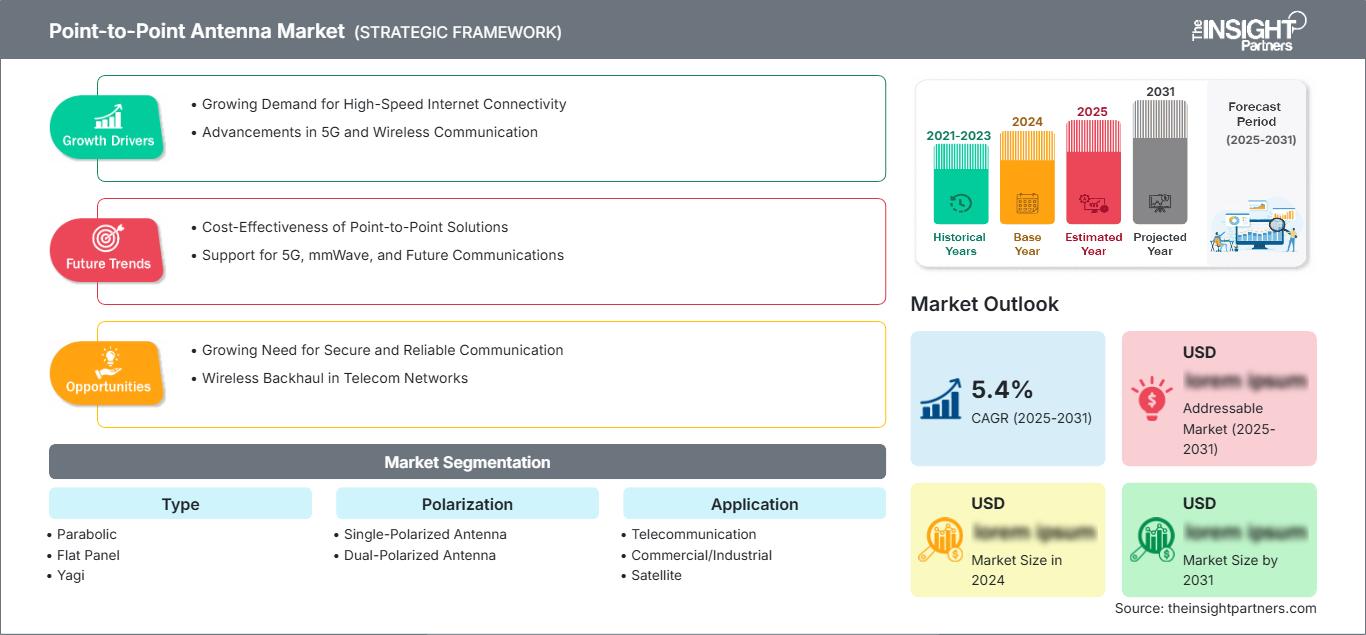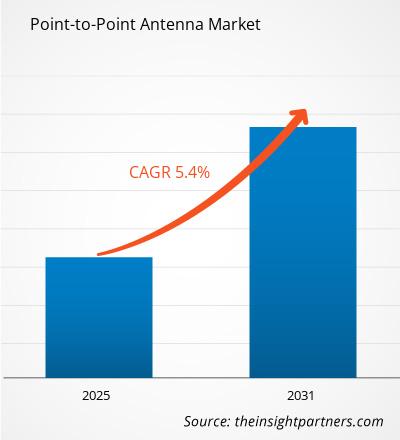页面已更新 :
Jan 2025
预计点对点天线市场在 2025 年至 2031 年期间的复合年增长率为 5.4%,市场规模将从 2024 年的 XX 百万美元扩大到 2031 年的 XX 百万美元。
该报告按类型(抛物面、平板、八木)、极化(单极化天线、双极化天线)、应用(电信、商业/工业、卫星、军事和国防、其他)细分。全球分析进一步细分为区域和主要国家。该报告以美元提供上述分析和细分的价值。
报告目的
Insight Partners 撰写的《点对点天线市场》报告旨在描述当前形势和未来增长、主要驱动因素、挑战和机遇。这将为各种商业利益相关者提供见解,例如:
- 技术提供商/制造商:了解不断变化的市场动态并了解潜在的增长机会,使他们能够做出明智的战略决策。
- 投资者:对市场增长率、市场财务预测和整个价值链中存在的机会进行全面的趋势分析。
- 监管机构:规范市场政策和警察活动,旨在最大限度地减少滥用,维护投资者的信任和信心,维护市场的完整性和稳定性。
点对点天线市场细分类型
- 抛物面天线
- 平板天线
- 八木天线
极化天线
- 单极化天线
- 双极化天线
应用
- 电信
- 商业/工业
- 卫星
- 军事和国防
地理分布
- 北美
- 欧洲
- 亚太地区
- 中东和非洲
- 南美洲和中美洲
自定义此报告以满足您的要求
您将免费获得任何报告的定制,包括本报告的部分内容,或国家级分析、Excel 数据包,以及为初创企业和大学提供超值优惠和折扣
点对点天线市场: 战略洞察

- 获取本报告的主要市场趋势。这个免费样本将包括数据分析,从市场趋势到估计和预测。
点对点天线市场增长动力
- 高速互联网连接需求不断增长:对快速可靠的互联网连接的需求不断增长,尤其是在偏远和服务欠缺的地区,是点对点天线市场的主要驱动力之一。随着企业、政府和消费者对高速互联网接入的需求不断增长,对高效无线通信系统的需求也在增长。点对点天线是一种经济高效的方式,无需光纤等大量基础设施即可提供长距离高带宽连接。这种趋势在传统宽带解决方案有限的农村和郊区尤为重要。
- 5G 和无线通信的进步:5G 网络的推出是点对点天线市场的重要驱动力。5G 技术需要高容量、低延迟的通信系统来支持自动驾驶汽车、智慧城市和物联网等应用所需的海量数据传输。点对点天线在为 5G 网络提供回程基础设施方面发挥着至关重要的作用,它能够高效可靠地在蜂窝塔、基站和数据中心之间进行通信。预计 5G 技术的采用将进一步推动对点对点天线的需求。
点对点天线市场未来趋势
- 点对点解决方案的成本效益:点对点天线最显著的优势之一是其与光纤等其他通信解决方案相比的成本效益。对于企业和电信运营商而言,投资点对点无线通信基础设施通常比铺设光纤更经济,尤其是在光纤安装成本过高的地区。点对点天线的成本效益,加上对更快互联网和移动服务日益增长的需求,使其成为一种无需在物理基础设施上投入大量资金即可扩展网络覆盖范围的极具吸引力的选择。
- 支持 5G、毫米波 (mmWave) 和未来通信:随着电信基础设施的发展,点对点天线市场有望支持 5G 网络的扩展和毫米波 (mmWave) 频率的使用。这些天线对于提供下一代应用(包括自动驾驶汽车、物联网设备和超高速宽带)所需的高速、大容量无线通信至关重要。未来趋势将侧重于提高天线效率、波束成形技术和处理更高的频率,从而实现更快、更可靠的点对点连接。
点对点天线市场机遇
- 对安全可靠通信的需求日益增长:点对点天线之所以受到青睐,是因为它们可以在两个固定位置之间提供安全的直接通信链路。在国防、政府和企业通信领域,由于网络攻击风险,在没有公共网络的情况下维护私密安全的数据传输变得越来越重要。点对点天线可确保可靠、专用的通信链路,消除拦截风险。随着人们对网络安全和数据隐私的日益关注,对此类安全通信解决方案的需求也将不断增长。
- 电信网络中的无线回程:电信运营商越来越多地采用无线回程解决方案,这是因为点对点天线在连接基站、塔台和中心局方面发挥着关键作用。在部署光纤电缆物理基础设施成本高昂甚至不切实际的地区,无线回程尤其具有优势。为了满足来自移动设备、云服务和流媒体平台日益增长的数据流量,对稳健且可扩展的回程网络的需求日益增长,这推动了点对点天线的发展。
点对点天线市场
The Insight Partners 的分析师已详尽阐述了预测期内影响点对点天线市场的区域趋势和因素。本节还讨论了北美、欧洲、亚太地区、中东和非洲以及南美和中美洲的点对点天线市场细分和地域分布。
点对点天线市场报告范围
| 报告属性 | 细节 |
|---|---|
| 市场规模 2024 | US$ XX million |
| 市场规模 2031 | US$ XX Million |
| 全球复合年增长率 (2025 - 2031) | 5.4% |
| 历史数据 | 2021-2023 |
| 预测期 | 2025-2031 |
| 涵盖的领域 |
By 类型
|
| 覆盖地区和国家 | 北美
|
| 市场领导者和主要公司简介 |
|
点对点天线市场参与者密度:了解其对业务动态的影响
点对点天线市场正在快速增长,这得益于终端用户需求的不断增长,而这些需求的驱动因素包括消费者偏好的演变、技术进步以及对产品优势的认知度的提升。随着需求的增长,企业正在扩展其产品线,不断创新以满足消费者需求,并抓住新兴趋势,从而进一步推动市场增长。

- 获取 点对点天线市场 主要参与者概述
主要卖点
- 全面覆盖:该报告全面涵盖了点对点天线市场的产品、服务、类型和最终用户的分析,提供了整体格局。
- 专家分析:该报告基于对行业专家和分析师的深入了解而编写。
- 最新信息:由于该报告涵盖了最新信息和数据趋势,因此确保了业务相关性。
- 定制选项:此报告可以根据特定客户要求进行定制,并适合业务策略。
因此,关于点对点天线市场的研究报告可以帮助引领解码和理解行业情景和增长前景的线索。尽管可能存在一些合理的担忧,但本报告的总体优势往往大于劣势。
- 历史分析(2 年)、基准年、预测(7 年)及复合年增长率
- PEST和SWOT分析
- 市场规模、价值/数量 - 全球、区域、国家
- 行业和竞争格局
- Excel 数据集
近期报告
相关报告
客户评价
购买理由
- 明智的决策
- 了解市场动态
- 竞争分析
- 客户洞察
- 市场预测
- 风险规避
- 战略规划
- 投资论证
- 识别新兴市场
- 优化营销策略
- 提升运营效率
- 顺应监管趋势
我们的客户































87-673-9708

ISO 9001:2015



 获取免费样品 - 点对点天线市场
获取免费样品 - 点对点天线市场